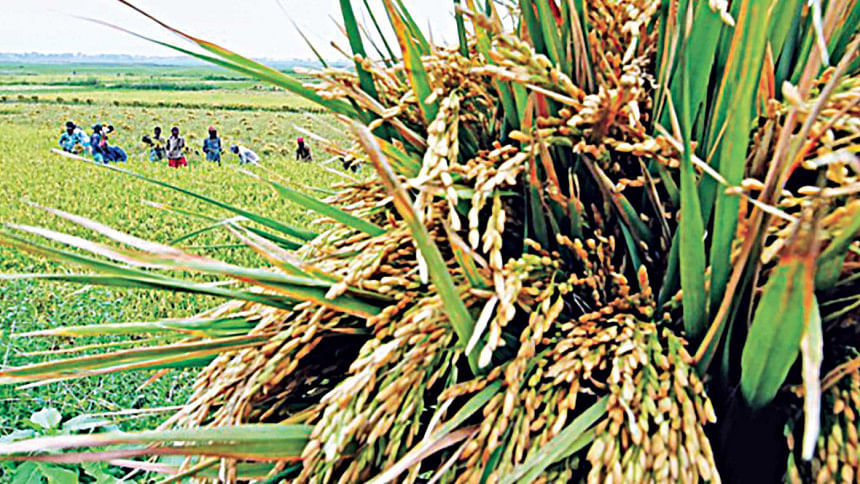Are we ready for Agriculture 4.0?

The fourth agricultural revolution (4AR), or Agriculture 4.0, refers to the anticipated changes from new technologies, particularly the use of artificial intelligence (AI) to make smarter planning decisions and for better integration of robotics. Intelligent machines could be used for growing and harvesting crops, weeding, milking livestock and distributing agrochemicals via drones. Other farming-specific technologies include new types of gene-editing tools to develop higher yielding, disease-resistant crops, vertical farming, and synthetic lab-grown meat.
A quick tour through Bangladesh's rural areas in December 2021 convinced me that productivity gains and income growth can happen faster if digital technologies are harnessed to improve crop yields, minimise losses, and enhance post-production operations. All major branches of the agricultural sector—including agronomy, horticulture, forestry, livestock, fisheries, and commercial farming—will be impacted.
Bangladesh is gearing up for the fourth industrial revolution (4IR) and there is an atmosphere of urgency, which is understandable. The country has set an ambitious goal to graduate from LDC status in 2026, become an upper-middle-income country by 2031, and achieve high-income country status by 2041.
In this context, Bangladesh is likely to see the impact of 4IR on agriculture as much as any other sector of the economy. Our traditional agriculture, particularly crop production where smallholders are in the majority, is ripe for a technological change.
Close to 50 percent of Bangladesh's population is primarily employed in agriculture, with more than 70 percent of its land dedicated to growing crops. Therefore, the potential for using technological tools in agriculture is enormous. One could even say that 4AR has already made some inroads in all major crops cultivated including rice, jute, wheat, tea, pulses, oil seeds, vegetables and fruits. Nonetheless, our agriculture "has remained largely subsistence based, with uncertain crop yields and inefficient infrastructure limiting the ability of farmers to fully commercialise their production," according to a recent FAO report. It is expected that 4AR will free cultivators from the back-breaking labour they endure to grow and harvest crops and, in addition, raise the productivity of land and labour.
In Bangladesh, AI and big data are already being applied in aquaculture and dairy farming. "For the small farmer-dominated Bangladesh agriculture, advances in computing power, connectivity, artificial intelligence, biotechnology and GIS (geographic information system), and other more capable technologies hold a tremendous promise," according to Dr M. K. Mujeri, an economist and former DG of Bangladesh Institute of Development Studies (BIDS).
Let us take the case of rice production. There are several decisions that a cultivator, whether a small subsistence farmer or a plantation owner, has to take. These can be broken down into eight steps: selection of crop(s), land preparation, seed-sowing and transplantation, irrigation and fertilisation, crop maintenance (including use of pesticides, crop pruning, etc.), harvesting, post-harvesting activities (drying, husking, milling, etc.) and marketing. Even in subsistence agriculture, these are complex processes and the scope for improvement is ever-present. For the Boro crop, for example, AI has been successfully used for irrigation and weed control with the help of sensors and other means embedded in robots and drones. "These technologies save the excess use of water, pesticides, herbicides, maintain the fertility of the soil, [and] also help in the efficient use of manpower," according to a scientific study carried out by Tanha Talaviya and others.
In a recent column in The Wall Street Journal, former World Bank president Robert Zoellick highlighted some benefits of digital technologies. "Modern farmers analyse field, crop, livestock, and aquaculture data. Agricultural marketing depends on current information on prices, export and import sales, insurance and transport data. Digital agronomy can boost environmental sustainability as well, because farmers use 70 percent of the world's freshwater supplies and a third of production is lost or wasted."
One could say with certainty that new technologies will emerge more rapidly now that we have learned so much from adapting to a major catastrophic event such as the Covid-19 pandemic. Bangladesh's challenge is to transform our education programmes and skills development infrastructure to deliver the talents needed for an innovative, digitised, and post-agricultural economy in the forthcoming 4AR.
The growers must be primed, and a support system—including government extension services—must be in place, to adopt technology and innovations that will make the industry, agriculture, and service sectors more productive and in sync with the global supply chain. The investment and infrastructure that supports the total transformation that will accompany this revolution need to be there both as a precondition and as a catalyst for 4AR.
Research policies in the public and private sectors need to guide our trajectory, and Bangladesh Bureau of Statistics can step in by providing internal and external coordination with statistics producers and users. Additionally, in order to tackle climate change and the rise of water levels and salinity of the soil in many regions across Bangladesh, new farming techniques need to be adopted by farmers, who need proper knowledge and guidance. With the help of government research and funding, these new methods can enable higher crop yields using up much less space.
There are, however, a few potential negative consequences of an unplanned implementation of 4AR in rural areas, such as increased unemployment, accelerated landlessness, and growing indebtedness. Policymakers need to be conscious that the transformation in the rural economy must work for everyone, be it farmers, landowners, farm workers, and the rural non-farm sectors.
A possible side effect and stimulant for 4AR is the creation of non-farm employment in rural areas. We can see the benefit of such a strategy from the recent experience of India. After the pandemic took hold in India, there was massive reverse migration from urban areas in its wake, and many found employment in the rural sectors. The key would be structural transformation towards inclusive agriculture and rural development, along with supportive high-productivity micro, small and medium enterprises (MSMEs), according to Dr Mujeri. Other sub-sectors where 4AR can make an impact are commercial farms, tea gardens, greenhouse-based agriculture, recirculation aquaculture systems (RAS), and hydroponics.
Dr Abdullah Shibli is an economist and serves as senior research fellow at the US-based International Sustainable Development Institute (ISDI).

 For all latest news, follow The Daily Star's Google News channel.
For all latest news, follow The Daily Star's Google News channel. 



Comments